The Bundesliga’s matchday 11 saw Wolfsburg host Bayer Leverkusen at the Volkswagen Arena. Both sides were without a league win for several games, and both floating aimlessly in mid-table. In a cagey affair which saw the two sides go toe to toe, Karim Bellarabi’s first-half goal and Paulinho’s injury-time doubler was enough to seal three points to take back to Leverkusen.
This tactical analysis will dissect the two sides’ tactics and use analysis to highlight how key areas of their systems lead to the outcome of the match, a 2-0 away victory for Peter Bosz’s outfit.
Lineups
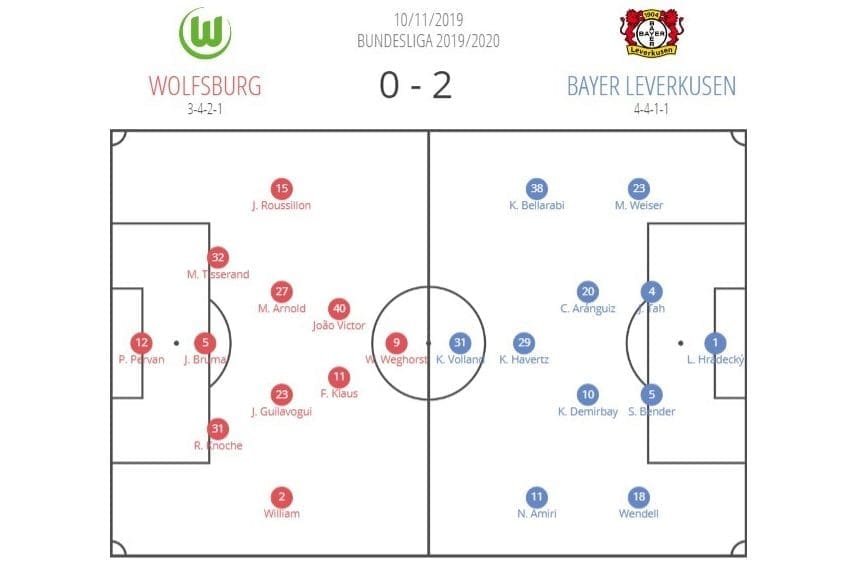
Wolfsburg deployed a 3-4-2-1 for the tie, which Oliver Glasner has shown a strong preference to all season. The Austrian often alternates between the 3-4-2-1 and a 3-4-3, which are very similar in principle and only differ in how narrow or wide the two advanced wingers play. In terms of personnel changes, Glasner made two alterations to his starting lineup from the 3-1, Europa League defeat to Gent in midweek. Renato Steffen and Josip Brekalo made way for Jerome Roussillon and Felix Klaus.
In the away dugout, Bosz opted for a 4-2-3-1, despite the above graphic from Wyscout listing the lineup as a 4-4-1-1. Although very similar, the formations differ in how advanced the wingers are, who were predominantly relatively high up the pitch in this Bundesliga clash. Therefore, the tactics deployed by Leverkusen were the same as that which they used in the midweek 2-1 victory over Atletico Madrid at the BayArena in the Champions League; with no changes in the starting XI either.
Leverkusen’s energetic press
Having realised that die Wolfe may be low on confidence due to shipping 12 goals in their last three outings, and without a win in seven league and cup ties, Bosz deployed a highly energetic counter-press. The method behind this was to make the Wolfsburg backline panic on the ball when they tried to play out from the goalkeeper. In doing so Leverkusen stationed themselves as high up the pitch as possible when the home side had a goal kick, in an attempt to pen them in.
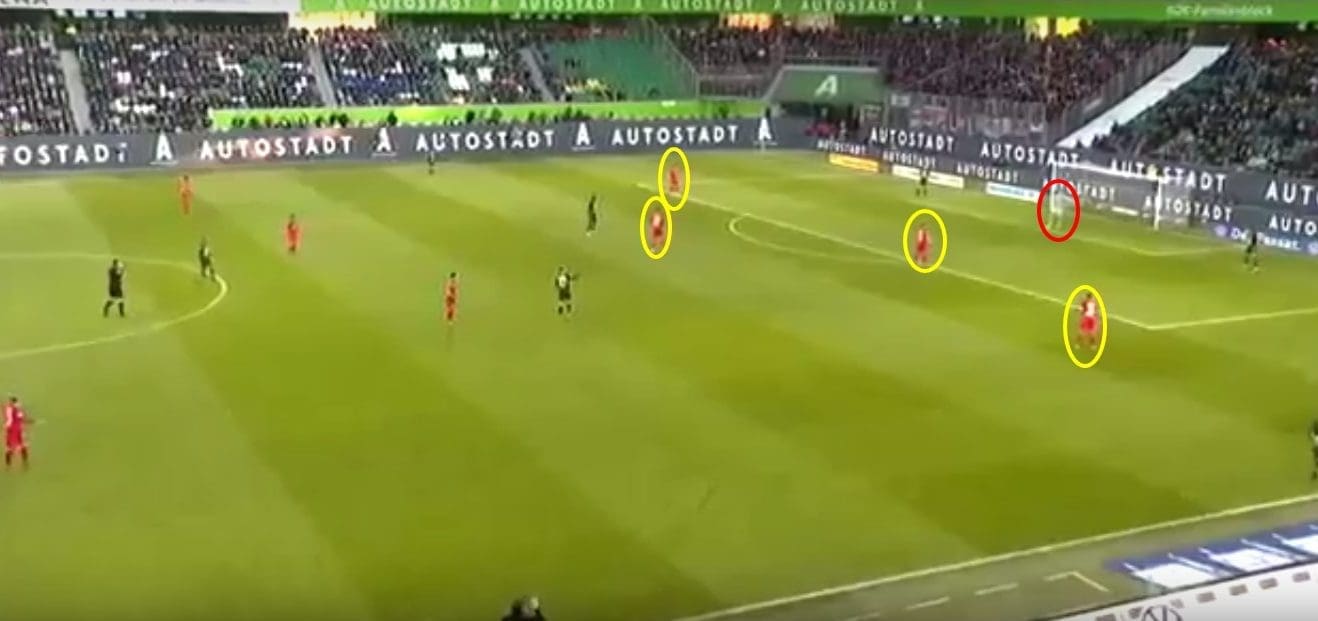
As can be seen here, the home side has a goal kick and die Werkself are stationed as high up the pitch as possible, just on the edge of Wolfsburg’s 18-yard box. The result of this being that Pavao Pervan signals his central defenders, who have split to provide short passing options, to move further up the pitch as a short goal kick is not viable. Therefore, the kick must be taken long and that gives Leverkusen a higher probability of winning it back immediately.
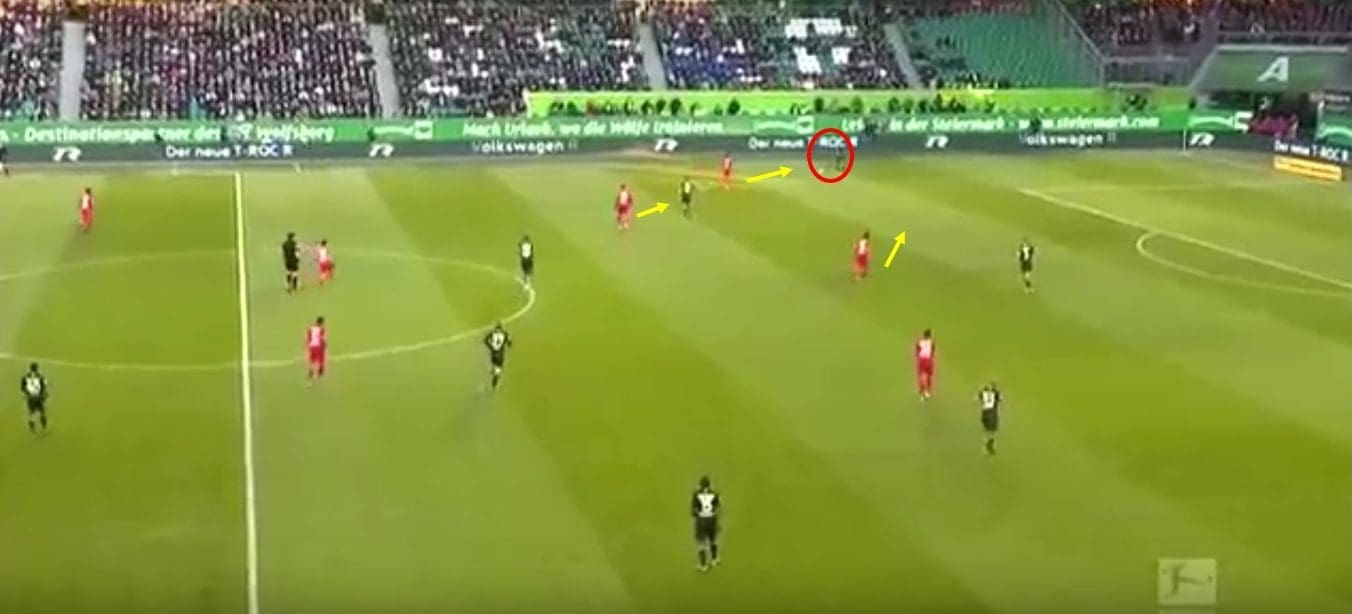
Here can be seen what happened when Wolfsburg opted to play the ball short. As previously mentioned, Bosz’s press was highly energetic and required high levels of energy from the front line. This was because, when the ball was played short, the man closest would immediately and quickly press the ball. Due to the speed of the individual pressing, on this occasion by Nadiem Amiri, there was occasionally no pressing structure other than the players behind moving outwards to cut passing lanes, as shown by the yellow arrows.
Wolfsburg’s retaliation to the press
Due to Leverkusen’s effective counter-press, life was made difficult for die Wolfe. Instead of being able to play through the thirds, the home side had to play the ball long. This tactic was enabled by the usefulness of having Wout Weghorst as the spearhead of the Wolfsburg attack, who provided an outlet for long balls forward. However, this came at a cost as it became more difficult for the home side to retain possession.
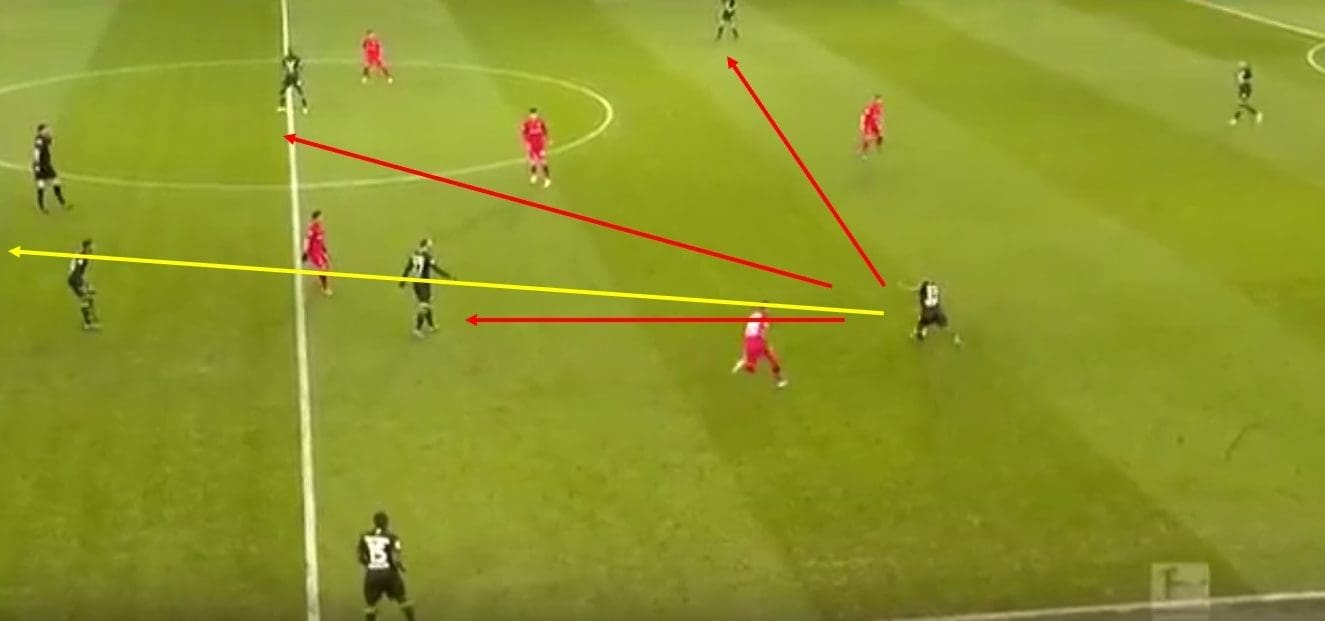
Here it can be seen how Wolfsburg opted to play the ball long to alleviate pressure on the backline from Leverkusen’s counter-press. With Bellarabi applying pressure to the ball quickly, despite having several shorter passing options with a higher probability of keeping the ball – as marked by the red arrows – Marcel Tisserand opts to punt the ball long to Weghorst. This is marked by the yellow arrow, but the pass is unsuccessful, and possession is turned back to the away team.
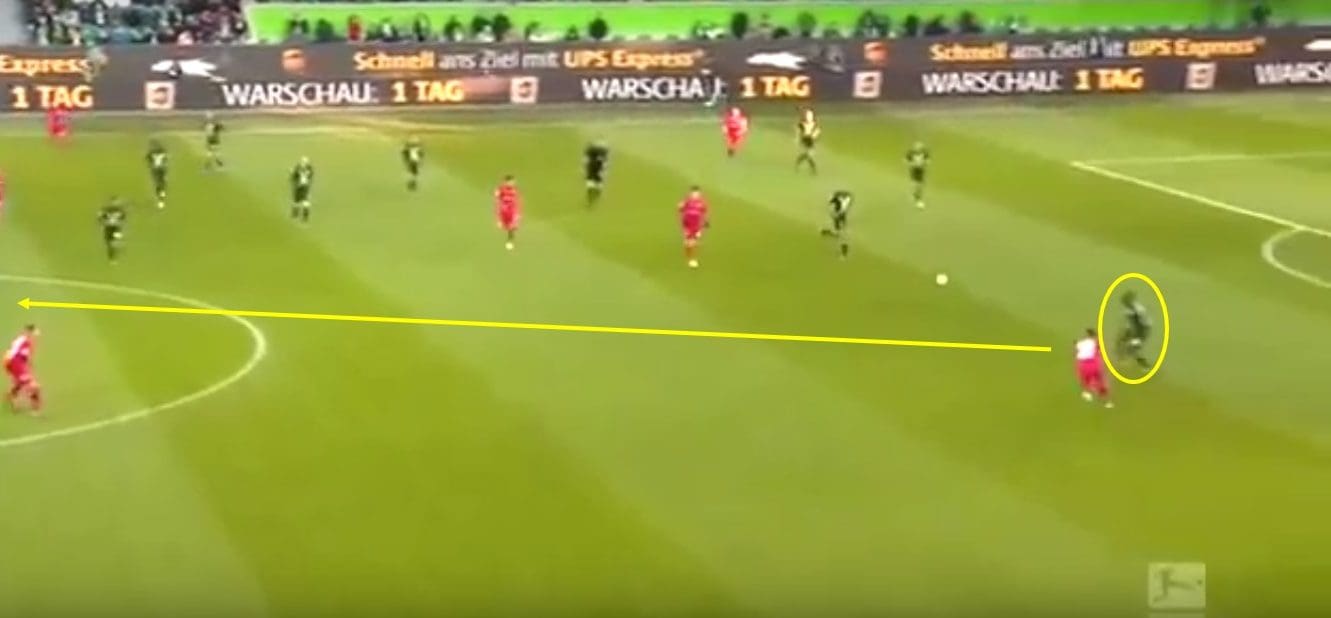
Here, another example of die Wolfe playing the ball forward quickly can be seen. Again, Bellarabi is applying pressure to the ball quickly, however, this time it is Roussillon receiving possession. Despite having many options to his right, the Frenchman plays the ball long and lofted, directly up the centre of the pitch towards Weghorst with his first touch; quickly moving the ball away from the defensive third.
Glasner’s intelligent press
Unlike the fast and energetic press of Bosz, Glasner deployed a press which required more intelligence from his attackers as opposed to always charging down the man in possession quickly. Not that that goes to say it was any more or less effective. Wolfsburg’s press would allow Leverkusen’s backline time on the ball, or at least the perception that they had time on the ball. In reality, Weghorst and an accompanying winger would set traps for the away side before springing into a press.
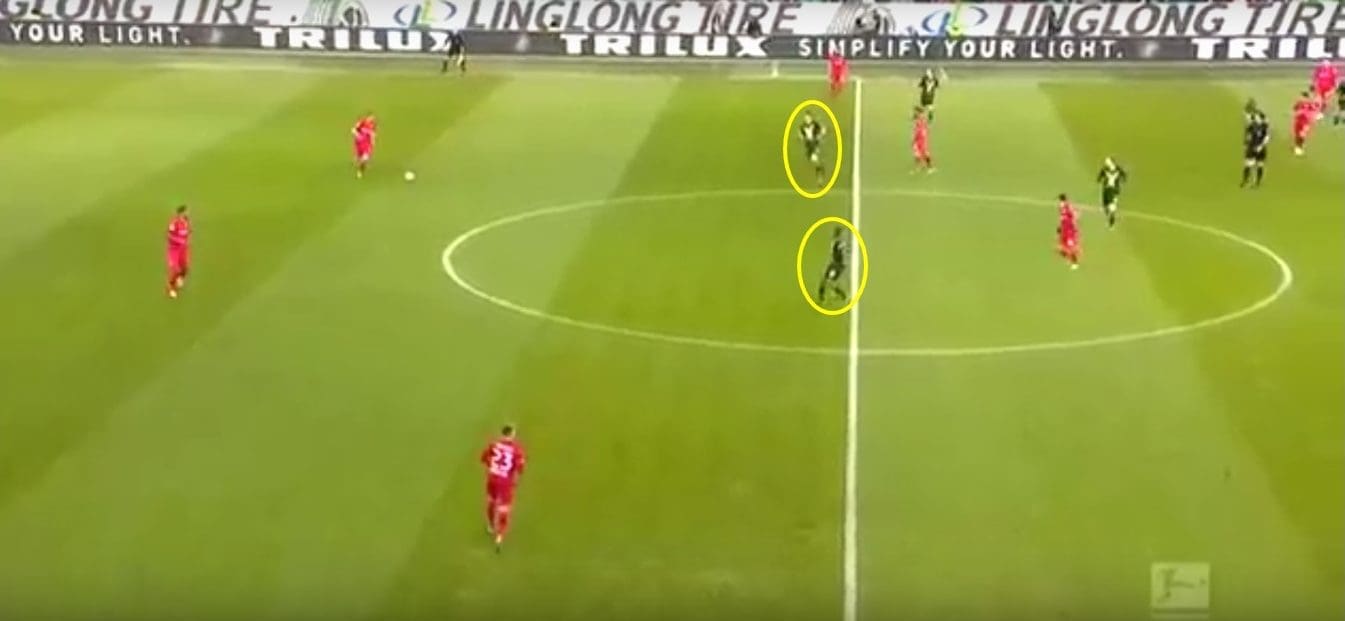
Here, Weghorst and Joao Victor can be seen setting the trap in the first phase of their press. The two attackers look to have a distance between themselves and the ball as they know the Leverkusen backline like to shift the ball from right to left until they find an opening – which will be discussed later in the tactical analysis. However, they are not giving the backline the time to find their pass as it may appear, they are biding their time for the moment where the duo can spring into life and press a defender into a mistake.
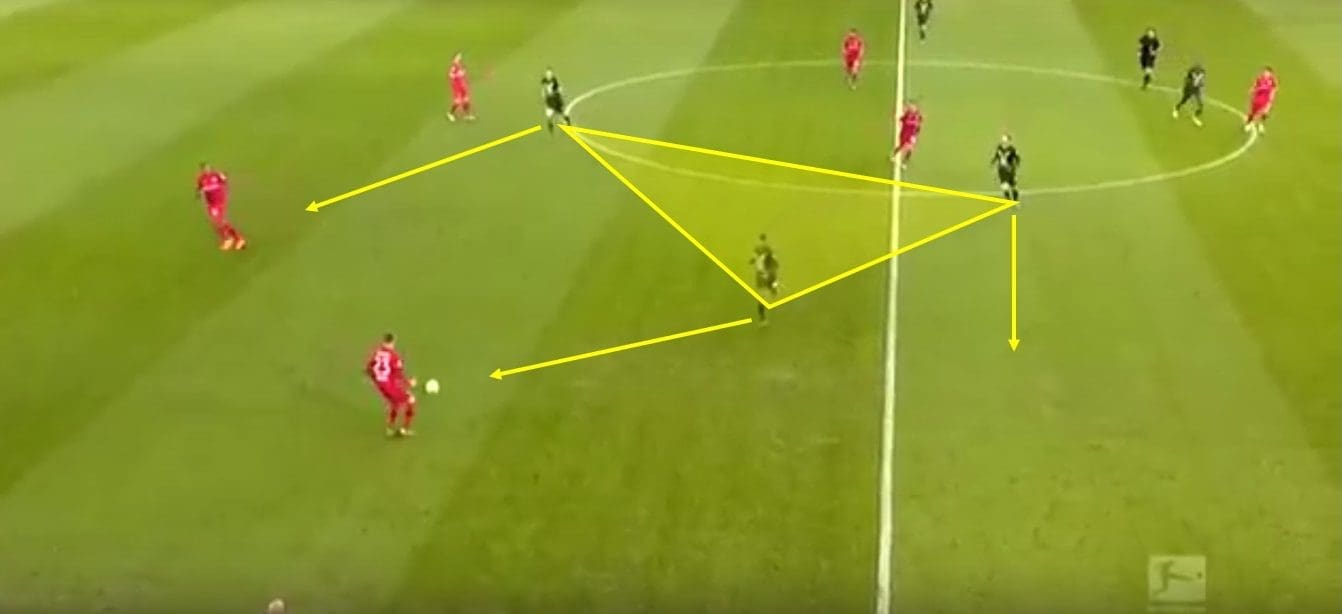
The above annotation is taken from three seconds later in the game. As can be seen, the ball has been shifted to Mitchell Weiser at right-back after being shifted across the backline and the attackers have sensed their moment. Victor has initiated the press and quickly closes down the man in possession of the ball, Weghorst then quickly shuts down the passing options back across the defence where he would look to play it back across, and a midfielder provides support to cut any further passing lines required.
Leverkusen’s intelligent reaction to the press
Here is where the game was won and lost, in how Leverkusen reacted to the press of die Wolfe. Instead of panicking when in possession and opting to cut out the middle third with long balls, as the home side had done in response to die Werkself’s press, the away side remained composed and stuck with their tactics. This composure from Leverkusen ultimately led to their first goal and allowed them to control the game – finishing with 54% possession.
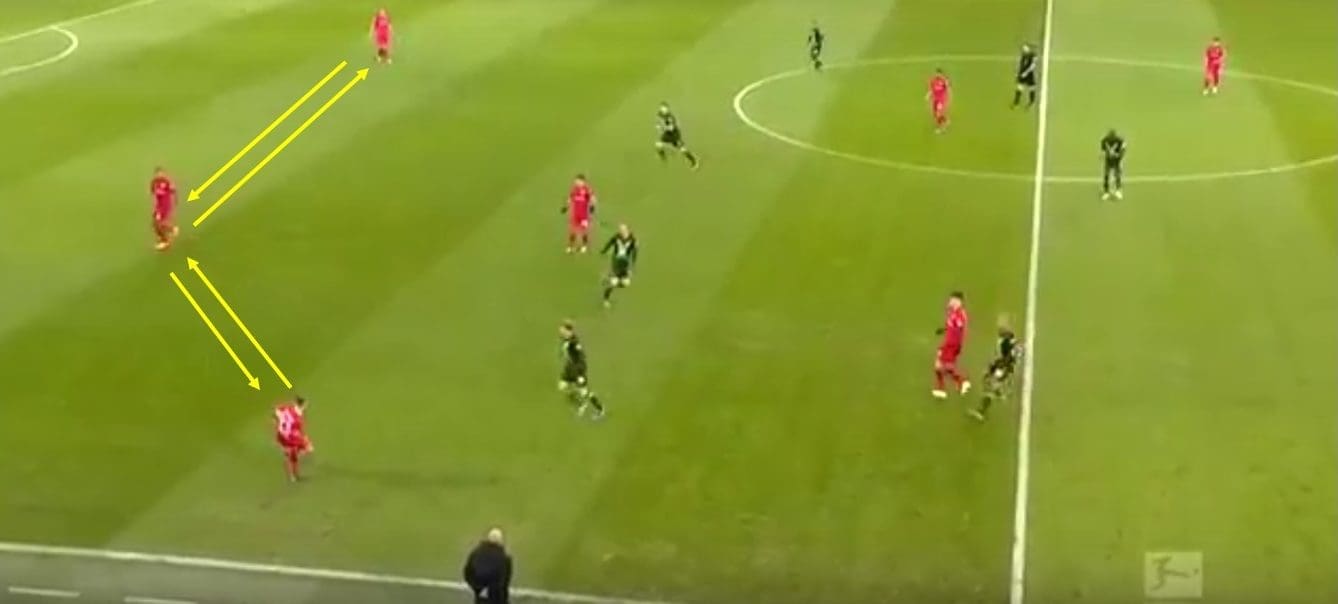
Here, it can be seen how Bosz’s side likes to pass the ball from one side, then back to the other across the backline. This is so Leverkusen can bide their time on the ball and retain possession until they spot an appropriate opportunity to play the ball through the thirds, or even long, should the right opportunity present itself. Then, when Wolfsburg would press, Leverkusen would remain confident on the ball and suck the home side in, steadily playing back to the goalkeeper until die Wolfe’s attacking and middle third could be cut out with a long ball forward from Luka Hradecky.

As can be highlighted by Leverkusen’s pass map for the game, this tactic is clear. The top four of the away side’s passing links were between the defence and the goalkeeper, with Wendell and Sven Bender almost doubling the number of passes between them than the second-highest two players.
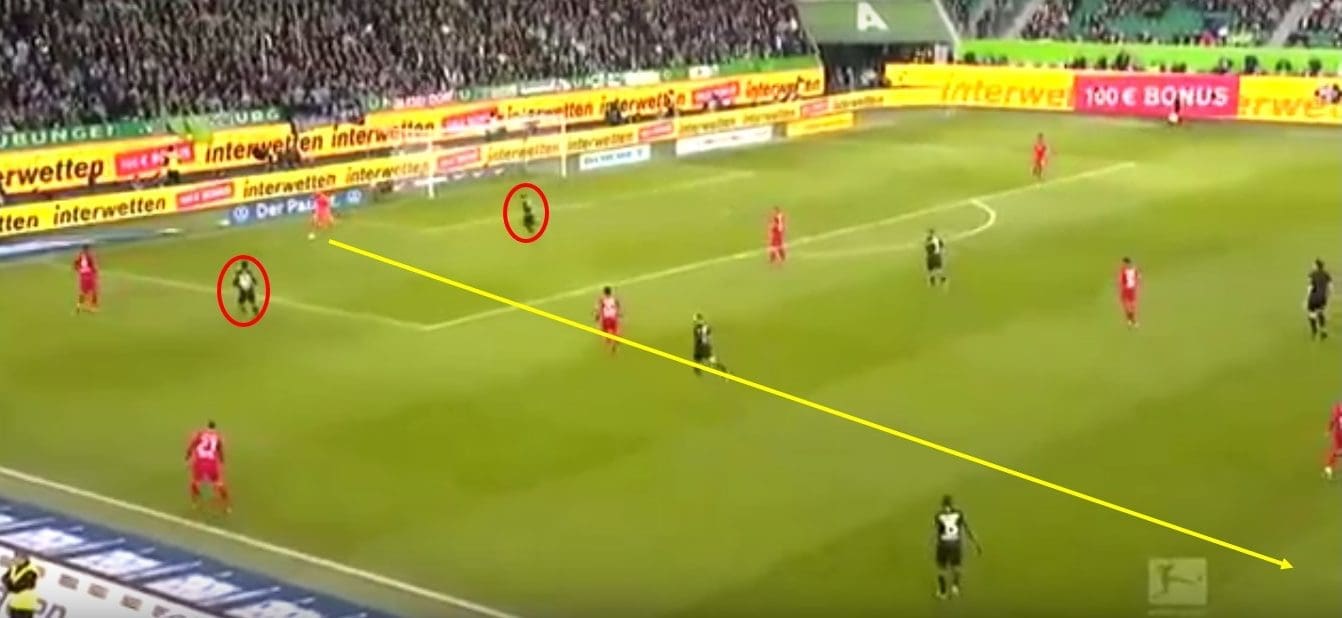
Here, the build-up to Bellarabi’s opening goal can be seen. Wolfsburg is in the second phase of their press, with Weghorst applying pressure directly to Hradecky. Leverkusen has sucked the middle and front thirds of their opposition in, and then relieve all the pressure from themselves by cutting out the two thirds with a long ball into the wide areas. This comes from calmness in possession of the ball which is vital for Leverkusen’s backline. The long ball forward into the channel eventually finds Bellarabi, who then beat the Wolfsburg defensive line and finish a tidy, fast attacking move from the away side.
Conclusion
Oliver Glasner will be starting to have growing concerns over the safety oh his job should the current rut continue, with die Wolfe having gone eight games in all competitions without a win – their last a 1-0 home victory over Union Berlin. Despite winning in the Champions League in midweek, Bosz will be pleased that his side was able to return to winning ways in the Bundesliga. Also, that his side’s composure and the technical ability of his defenders – where Wolfsburg’s had little – was able to claim them the three points.
This tactical analysis has broken down the clash between Wolfsburg and Bayer Leverkusen, highlighting areas of the two sides tactics and then using analysis to show how that affected the outcome of the match.

If you love tactical analysis, then you’ll love the digital magazines from totalfootballanalysis.com – a guaranteed 100+ pages of pure tactical analysis covering topics from the Premier League, Serie A, La Liga, Bundesliga and many, many more. Buy your copy of the November issue for just ₤4.99 here





Comments